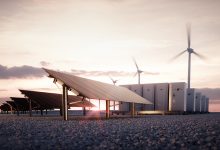The latest analysis from Bloomberg NEF dismisses talk of a new coal-fired power generator in Australia, and says that cheap wind and solar, supported by flexible technologies such as storage, and driven by a “people-powered revolution” in rooftop installations, will kick coal out of the generation mix in Australia.
BNEF says its annual set piece analysis, the highly regarded New Energy Outlook (NEO), shows that the share of renewable energy in Australia’s grid will be 57 per cent by 2030, and 84 per cent by 2050.
“This year’s NEO confirms that Australia’s coal generators are on their way out. The only remaining question is when, not if, they exit,” said Leonard Quong, the head of BNEF in Australia.
“The economics of Australia’s electricity system are already re-orientating towards renewables, a trend that’s expected to accelerate.
“The future grid will be underpinned by cheap wind and solar, with batteries and pumped hydro to smooth variability, while gas and long-duration storage will provide additional backup to the market.”
This has been the broad conclusion of numerous other bodies, scientific organisations and independent analysts, even if the very idea that Australia could get to 50 per cent renewable share by 2030 – as targeted by Labor ahead of the recent federal election – is resisted by the Coalition government and the Murdoch media.
The 50 per cent renewables target was demonised by the Coalition and the main business lobbies as reckless and economy wrecking, but it is considered to be the minimum that will be achieved – even under business as usual – by most analysts because of the cheap cost of renewables and the plunging cost of storage and other new enabling technologies.
Consumers will play a key role in this transformation because the economic advantage to households and businesses of installing rooftop solar, batteries and then electric vehicles will be overwhelming.
Quong speaks of an “economic tidal wave” that will re-shape the market.
The NEO is a serious piece of work, resulting from eight months of analysis and modelling by a 65-strong team at BNEF. It is based on real-life events, on announced project pipelines and power system dynamics. It assumes that current subsidies expire and that energy policies around the world remain on their current bearing.
In Australia – and despite all the talk of extending the life of coal plants and even investing in a new one in Collinsville, Queensland – that coal capacity will drop by one-third to 18GW by 2030 and then to just 6GW in 2040.
This will be replaced by a “people powered revolution” that will see the amount of rooftop solar jumping from around 10GW at the end of 2019 to more than 38GW by 2030 – which means that the current record levels of installation of around 2GW a year will continue for another decade.
By 2050, rooftop solar capacity will increase to 61GW, enough to supply nearly one-quarter of the country’s electricity demand, BNEF suggests.
Rooftop solar will be supported by behind-the-meter storage and demand response and together this will represent 39 per cent of all capacity in Australia by 2050.
In total, BNEF sees utility- and small-scale PV surge to 115GW by 2050, and wind to 27GW. Battery storage capacity grows to at least 26GW in 2050, with the vast majority (19GW) installed by households and businesses behind-the-meter.
Gas capacity will also need to increase, from 18GW today to 29GW in 2050, to assist with seasonality and rare periods of extremely low renewable production. Almost all coal capacity will close by 2050.
This amounts to total investment of around $A150 billion into renewable energy generation, of which nearly half will come from households and businesses. “Coal will receive almost no new capital,” it says.
The abundance of cheap renewables will be supported by flexible technologies such as pumped hydro, batteries, gas and demand response that will provide the system with reliable supply.
And BNEF notes that this will be driven by simple economics, and not ideology.
Solar and wind are already less than half the price of a refurbished coal plant, and by 2030 the cost of new solar and wind will be one-third of the price.
Electric vehicles will also make their mark, making up 28 per cent of all new car sales by 2030, and increasing to 61 per cent by 2050.










